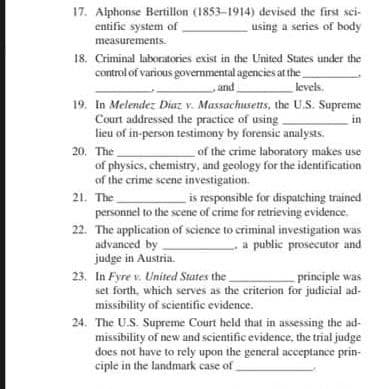17. Aiphonse Bertillon (1853-1914) devised the first sei- entific system of using a series of body measurements. 18. Criminal laboratories exist in the United States under the control of various governmental agencies at the and levels. 19. In Melendez Diaz v. Massachusetts, the U.S. Supreme Court addressed the practice of using lieu of in-person testimony by forensic analysts. 20. The of physics, chemistry, and geology for the identification of the crime scene investigation. 21. The personnel to the scene of crime for retrieving evidence. In of the crime laboratory makes use is responsible for dispatching trained 22. The application of science to criminal investigation was advanced by judge in Austria. a public prosecutor and 23. In Fyre v. United Stutes the set forth, which serves as the criterion for judicial ad- missibility of scientific evidence. principle was 24. The U.S. Supreme Court held that in assessing the ad- missibility of new and scientific evidence, the trial judge does not have to rely upon the general acceptance prin- ciple in the landmark case of
17. Aiphonse Bertillon (1853-1914) devised the first sei- entific system of using a series of body measurements. 18. Criminal laboratories exist in the United States under the control of various governmental agencies at the and levels. 19. In Melendez Diaz v. Massachusetts, the U.S. Supreme Court addressed the practice of using lieu of in-person testimony by forensic analysts. 20. The of physics, chemistry, and geology for the identification of the crime scene investigation. 21. The personnel to the scene of crime for retrieving evidence. In of the crime laboratory makes use is responsible for dispatching trained 22. The application of science to criminal investigation was advanced by judge in Austria. a public prosecutor and 23. In Fyre v. United Stutes the set forth, which serves as the criterion for judicial ad- missibility of scientific evidence. principle was 24. The U.S. Supreme Court held that in assessing the ad- missibility of new and scientific evidence, the trial judge does not have to rely upon the general acceptance prin- ciple in the landmark case of
Chapter14: Chromatography
Section: Chapter Questions
Problem 9P
Related questions
Question

Transcribed Image Text:17. Alphonse Bertillon (1853-1914) devised the first sci-
entific system of
using a series of body
measurements.
18. Criminal laboratories exist in the United States under the
control of various governmental agencies at the
and
levels.
19. In Melendez Diaz v. Massachusetts, the U.S. Supreme
Court addressed the practice of using
lieu of in-person testimony by forensic analysts.
20. The
of physics, chemistry, and geology for the identification
of the crime scene investigation.
in
of the crime laboratory makes use
is responsible for dispatching trained
21. The
personnel to the scene of crime for retrieving evidence.
22. The application of science to criminal investigation was
advanced by
judge in Austria.
23. In Fyre v. United States the
set forth, which serves as the criterion for judicial ad-
missibility of scientific evidence.
a public prosecutor and
principle was
24. The U.S. Supreme Court held that in assessing the ad-
missibility of new and scientific evidence, the trial judge
does not have to rely upon the general acceptance prin-
ciple in the landmark case of
Expert Solution
This question has been solved!
Explore an expertly crafted, step-by-step solution for a thorough understanding of key concepts.
Step by step
Solved in 2 steps

Knowledge Booster
Learn more about
Need a deep-dive on the concept behind this application? Look no further. Learn more about this topic, chemistry and related others by exploring similar questions and additional content below.Recommended textbooks for you


EBK A SMALL SCALE APPROACH TO ORGANIC L
Chemistry
ISBN:
9781305446021
Author:
Lampman
Publisher:
CENGAGE LEARNING - CONSIGNMENT

Principles of Instrumental Analysis
Chemistry
ISBN:
9781305577213
Author:
Douglas A. Skoog, F. James Holler, Stanley R. Crouch
Publisher:
Cengage Learning


EBK A SMALL SCALE APPROACH TO ORGANIC L
Chemistry
ISBN:
9781305446021
Author:
Lampman
Publisher:
CENGAGE LEARNING - CONSIGNMENT

Principles of Instrumental Analysis
Chemistry
ISBN:
9781305577213
Author:
Douglas A. Skoog, F. James Holler, Stanley R. Crouch
Publisher:
Cengage Learning